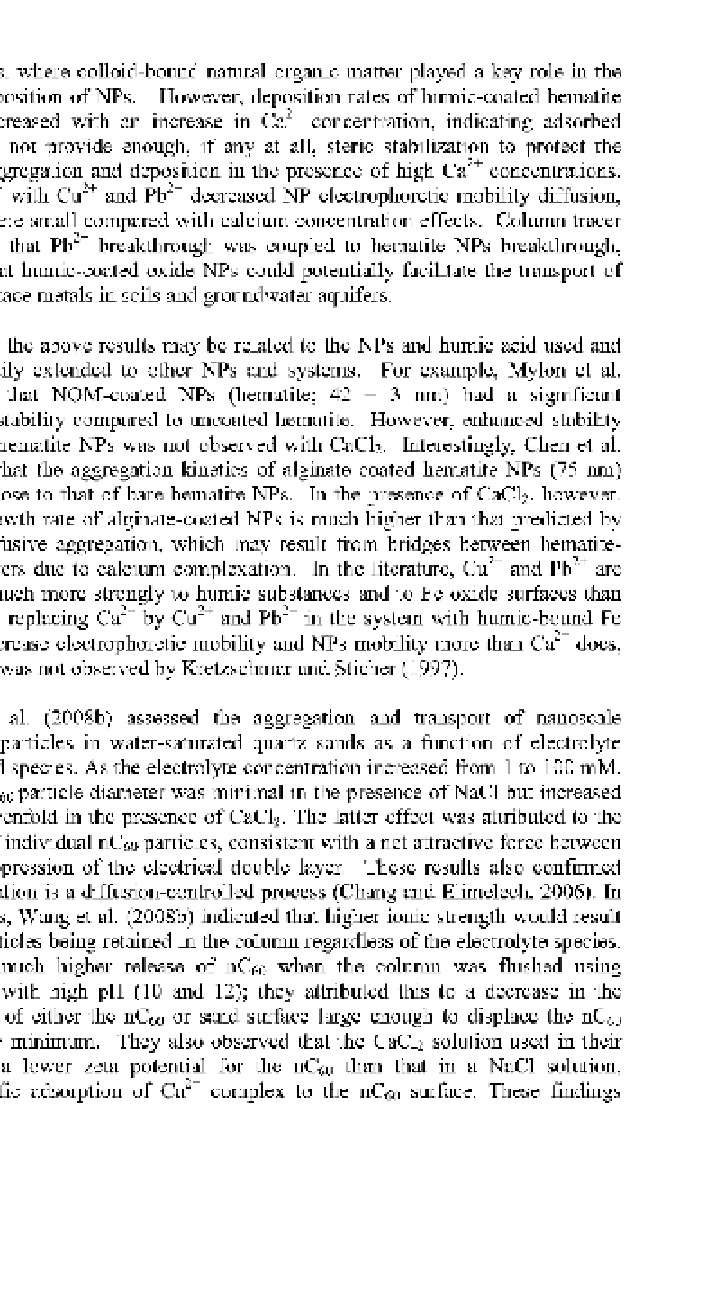Environmental Engineering Reference
In-Depth Information
immobile in soils, where colloid-bound natural organic matter played a key role in the
transport and deposition of NPs. However, deposition rates of humic-coated hematite
NPs strongly increased with an increase in Ca
2
+
concentration, indicating adsorbed
humic acid does not provide enough, if any at all, steric stabilization to protect the
particles from aggregation and deposition in the presence of high Ca
+
concentrations.
Substituting Ca
+
with Cu
+
and Pb
+
decreased NP electrophoretic mobility diffusion,
but the effects were small compared with calcium concentration effects. Column tracer
studies indicated that Pb
+
breakthrough was coupled to hematite NPs breakthrough,
demonstrating that humic-coated oxide NPs could potentially facilitate the transport of
strongly sorbed trace metals in soils and groundwater aquifers.
However, the above results may be related to the NPs and humic acid used and
may not be readily extended to other NPs and systems. For example, Mylon et al.
(2004) reported that NOM-coated NPs (hematite; 42 ± 3 nm) had a significant
enhancement in stability compared to uncoated hematite. However, enhanced stability
of NOM-coated hematite NPs was not observed with CaCi2. Interestingly, Chen et al.
(2006) reported that the aggregation kinetics of alginate-coated hematite NPs (75 nm)
are reasonably close to that of bare hematite NPs. In the presence of CaCi2, however,
the aggregate growth rate of alginate-coated NPs is much higher than that predicted by
conventional diffusive aggregation, which may result from bridges between hematite-
alginate gel clusters due to calcium complexation. In the literature, Cu
2
+
and Pb
2
+
are
known to bind much more strongly to humic substances and to Fe oxide surfaces than
Ca
2+
. Therefore, replacing Ca
2
+
by Cu
2
+
and Pb
2
+
in the system with humic-bound Fe
oxides would decrease electrophoretic mobility and NPs mobility more than Ca
+
does,
which, however, was not observed by Kretzschmar and Sticher (1997).
Wang et al. (2008b) assessed the aggregation and transport of nanoscale
fullerene (nCeo) particles in water-saturated quartz sands as a function of electrolyte
concentration and species. As the electrolyte concentration increased from 1 to 100 mM,
the change in nCeo particle diameter was minimal in the presence of NaCl but increased
by more than sevenfold in the presence of CaCi2. The latter effect was attributed to the
agglomeration of individual nCeo particles, consistent with a net attractive force between
particles and suppression of the electrical double layer. These results also confirmed
that nCeo aggregation is a diffusion-controlled process (Chang and Elimelech, 2006). In
their column tests, Wang et al. (2008b) indicated that higher ionic strength would result
in more nCeo particles being retained in the column regardless of the electrolyte species.
They observed much higher release of nCeo when the column was flushed using
deionized water with high pH (10 and 12); they attributed this to a decrease in the
surface potential of either the nCeo or sand surface large enough to displace the nCeo
from the primary minimum. They also observed that the CaCi2 solution used in their
study produced a lower zeta potential for the nCeo than that in a NaCl solution,
suggesting specific adsorption of Ca
+
complex to the nCeo surface. These findings

Search WWH ::

Custom Search